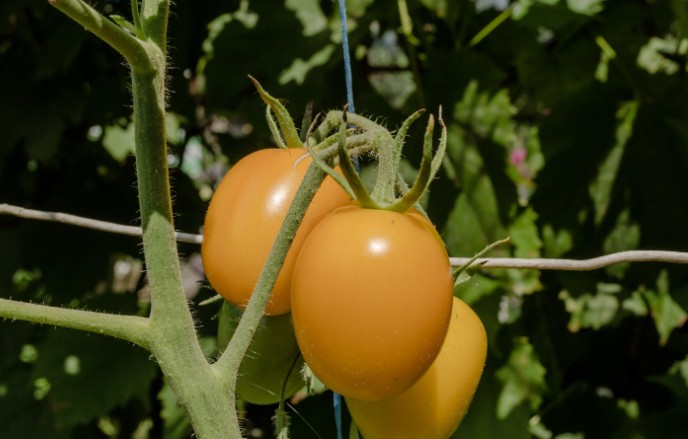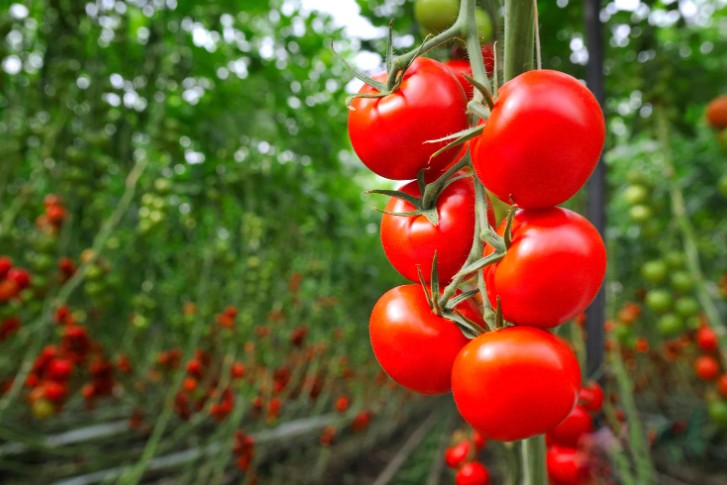- Common Problems with Growing Tomatoes in a Greenhouse
- Tips to Avoid These Greenhouse Tomato Problems
- Troubleshooting Table – Quick Fixes for Problems With Growing Tomatoes in a Greenhouse
- Conclusion – Can You Still Grow Great Tomatoes in a Greenhouse?
- FAQs About Problems With Growing Tomatoes in a Greenhouse
Growing tomatoes in a greenhouse is often seen as the perfect way to enjoy a longer growing season and consistent harvests. But while the controlled environment has many advantages, it also comes with its own set of challenges.
If you’re finding that your tomato plants aren’t thriving under glass, you’re not alone. Many UK gardeners encounter issues that are specific to greenhouse conditions.
In this guide, you’ll learn about the most common problems with growing tomatoes in a greenhouse, understand why they happen, and discover how to solve them.
Common Problems with Growing Tomatoes in a Greenhouse
Greenhouse gardening doesn’t guarantee success — especially with tomatoes, which are notoriously sensitive.
Below, we’ve listed the key problems you’re likely to encounter and explained why each one occurs.
1. Overheating and Poor Ventilation
Why Does This Happen?
Greenhouses trap heat — it’s their job. But too much heat, especially in summer, can stress your tomato plants.
Without proper ventilation, the temperature inside can easily exceed 30°C, which is too high for optimal fruiting.
Poor air circulation also increases the risk of fungal diseases and makes it harder for plants to absorb nutrients.

2. Excess Humidity and Fungal Infections
Why Is High Humidity a Threat?
Tomatoes dislike overly humid environments. When humidity levels rise, especially in enclosed greenhouses, fungal diseases like botrytis (grey mould), powdery mildew, and leaf spot thrive.
High humidity also interferes with transpiration, slowing down nutrient uptake and weakening your plants overall.
3. Pest Infestations: Aphids, Whiteflies, and Spider Mites
Why Are Greenhouses Prone to Pests?
While outdoor pests have natural predators, a greenhouse acts like a sealed buffet even for bugs in mattress.
Aphids, whiteflies, and spider mites multiply quickly in warm, humid environments, feeding on sap and transmitting viruses.
Once inside, they’re hard to control without manual removal or biological intervention.
4. Tomato Leaf Curl and Yellowing Leaves
What Causes These Symptoms?
These are common warning signs that something is wrong. Leaf curl can be caused by viral infections, inconsistent watering, high temperatures, or even over-fertilisation.
Yellow leaves may signal nitrogen deficiency or overwatering — both of which are easily triggered in the greenhouse setting.

5. Blossom End Rot
Why Does Blossom End Rot Occur in Greenhouses?
Blossom end rot is one of the most disappointing issues. It looks as black, sunken patches on the bottom of your tomatoes.
The primary cause is the Calcium deficiency, which frequently brought on by uneven watering.
In greenhouses, pots and grow bags dry out unevenly, and inconsistent moisture disrupts calcium flow to developing fruits.
6. Pollination Issues
Why Don’t Tomatoes Pollinate Easily Indoors?
In nature, wind and insects help tomato flowers self-pollinate. In a greenhouse, these natural aids are restricted or not found completely.
As a result, flowers may drop before setting fruit — a clear sign of poor pollination. You may need to hand-pollinate to ensure a good yield.
7. Inconsistent Watering and Root Problems
How Does Watering Impact Tomato Health?
Tomatoes are fussy drinkers. Inconsistent watering causes stress, leading to split fruit, poor growth, and root rot.
In greenhouses, the soil dries quickly, and without regular checks, it’s easy to over or underwater.
This also affects nutrient absorption and can lead to further complications like blossom end rot or leaf curl.
8. Soil and Container Limitations
Why Do Soil and Containers Matter So Much?
Greenhouse tomatoes are often grown in containers or grow bags, which means limited root space.
If the soil pH isn’t between 6.0 and 6.8, or if drainage is poor, your plants will suffer.
Over time, nutrients get depleted quickly in confined spaces, so frequent monitoring and replenishment are essential.
Tips to Avoid These Greenhouse Tomato Problems
Here are some practical steps to help you grow healthy, productive tomato plants in your greenhouse:
- Install automatic roof vents or use oscillating fans to maintain airflow
- Monitor humidity daily with a hygrometer
- Water consistently — little and often is better than soaking
- Feed regularly with a calcium-rich tomato fertiliser
- Introduce beneficial insects like ladybirds for natural pest control
- Hand-pollinate using a soft brush or jiggle the flower stems gently
- Prune side shoots & basel leave to raise air circulation

Troubleshooting Table – Quick Fixes for Problems With Growing Tomatoes in a Greenhouse
| Problem | Common Cause | Suggested Solution |
| Leaf Curl | Heat stress or viral infection | Improve airflow, prune infected leaves |
| Yellowing Leaves | Nitrogen deficiency | Apply balanced tomato fertiliser |
| Blossom End Rot | Inconsistent watering | Water evenly, add calcium supplement |
| Poor Fruit Set | Lack of pollination | Hand-pollinate using a soft brush |
| Fungal Diseases | High humidity | Ventilate regularly, space plants properly |
Conclusion – Can You Still Grow Great Tomatoes in a Greenhouse?
Absolutely — as long as you’re aware of the unique challenges that greenhouse environments present. From managing temperature and humidity to keeping pests at bay and ensuring proper watering, success is all about balance.
By recognising the early signs of problems and taking preventive action, you can enjoy healthy, vibrant tomatoes all season long — even in the unpredictable UK climate.
Related Article: How and When to Prune Hebe?
FAQs About Problems With Growing Tomatoes in a Greenhouse
1. How hot is too hot for greenhouse tomatoes?
Tomatoes prefer daytime temperatures between 18°C and 27°C. Anything above 30°C can cause blossom drop and poor fruit development.
2. Should you prune tomato plants in a greenhouse?
Yes, pruning improves air circulation, reduces the risk of disease, and helps direct energy into fruit production.
3. Do I need to pollinate greenhouse tomatoes manually?
In most cases, yes. Without bees or wind, you can hand-pollinate by gently shaking flower trusses or using a small paintbrush.
4. What’s the best soil pH for greenhouse tomatoes?
Aim for a pH between 6.0 and 6.8. Slightly acidic soil helps tomatoes absorb nutrients efficiently.


0 Comments